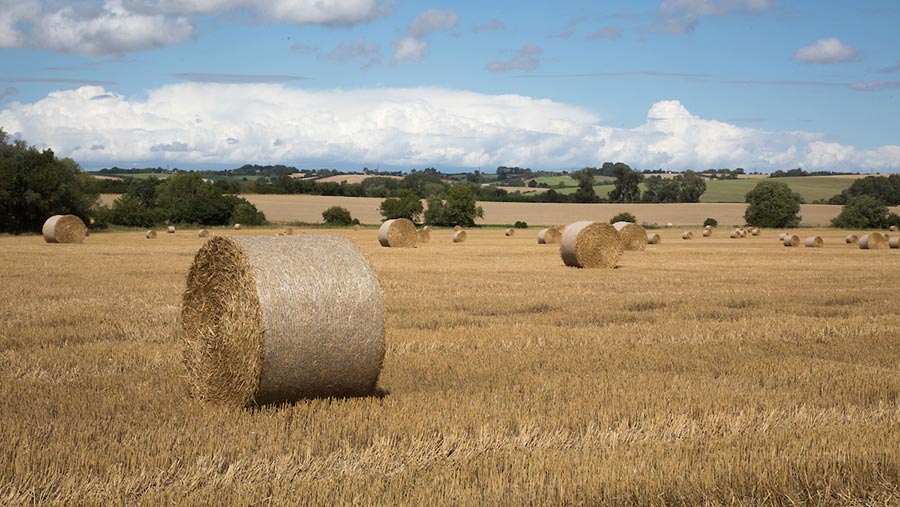Lifestyle buyers outbid farmers for farmland in 2018
 © Tim Scrivener
© Tim Scrivener Lifestyle buyers, investors and wealthy individuals have accounted for more than half of all farmland purchases for the first time ever, according to Strutt & Parker.
The result was that farmland values in 2018 were, in the face of Brexit-related uncertainties and unpredictable weather, more resilient than many had predicted.
See also: Top 6 issues that hold up farm sales and how to avoid them
Ranges of values had also increased significantly, as buyers were willing to pay more for location than land quality.
Average arable land prices in England increased by 2% in 2018 to £9,400/acre, according to the Strutt & Parker Farmland Database.
Although £1,300/acre down from its Q2 2015 peak, the value was only slightly south of the five-year average.
Non-farmer influence
“Our data confirms that over the past two years non-farmers have played an increasing role in the market,” said Strutt & Parker’s head of estate and farm agency, Michael Fiddes.
“Land in the right location remains in considerable demand for capital investment for many non-farming reasons, including development potential, privacy, tax reasons, or amenity.”
Mr Fiddes added: “For many of these investors, generating profits from farming is not their primary focus.”
The proportion of land bought by existing farmers was declining year on year, said the land agent, which was stretching the range of farmland prices which, was not reflected in average values.
“The price of arable land in England during 2018 ranged from a low of £4,575/acre to a high of £15,000/acre.
“Location rather than quality of land continues to be the key driver of the price achieved,” said Mr Fiddes.
Last year was the first time farmers had accounted for less than 50% of all English farmland values since Strutt & Parker began keeping records in 1996.
Why are farmers buying less land?
Declines in farm profitability and concerns over future changes to support payments meant farmers were taking a more cautious approach toward buying land, Mr Fiddes said.
“However, the most entrepreneurial farmers remain in the market for more land if it is in the right location and at the right price,” adding that the immediate future lack of supply was anticipated to support values.
“History shows that in times of uncertainty around CAP reform, supply of land in the market has tightened,” he said.
“Bare land in areas, where there is little interest from non-farming buyers, is where there is greatest downside risk, but it is likely to be a different story for land with strong appeal to non-farmers, or for land with strategic development potential.
“Overall, we expect that in 2019 and 2020 we could see a decrease in average farmland prices, but that growth will return from 2021 onwards.”
Strutt & Parker regional round-up
East of England – Giles Allen
- Average values £8,000-£9,000/acre, with exceptional sales topping £11,000/acre
- Increase in the acreage available in 2018
- Demand is stronger for farms in the southern half of the region
- Land in less accessible parts is attracting bids of £6,000-£8,000/acre
- Key to success is local knowledge
North – Will Parry
- Arable values ranging between £6,500 and £12,500/acre, with the majority of business happening within the £7,250-£8,750/acre bracket
- Strong interest in smaller blocks of land at the super-prime end of the property scale
- The middle ground has not performed so well, leading to the number of completed sales being down
- The few buyers in the marketplace are highly motivated
East Midlands – Sam Holt
- The top end of sales have achieved prices of more than £14,000/acre, while less popular areas of arable land have changed hands for £6,300/acre
- Almost everything that has gone on the market has sold and sold well
- The right location, combined with a shortage of available land and a surplus of buyers, is driving the value of property upwards
South West – Will Langmead
- Arable land is selling for £8,500-£9,500/acre, while pasture is going for £6,000-£7,500/acre
- Values in the region are underpinned by strong demand from amenity buyers
- There is demand from people who are comfortable with the idea of holding land for multiple generations, so are not viewing it as a short-term investment
- The best sales are a result of regional agents knowing exactly which buyers are out there and what they are after – enabling them to tailor their marketing approach accordingly
South East – Matthew Gibson
- Most demand coming from neighbouring farmers looking to pick up extra land on their doorstep
- Best-in-class residential farms are selling well
- Buyers have become fussier about properties where there are compromises to be made
Central and West Midlands – Matthew Sudlow
- Majority of farms achieving £10,000-£12,000/acre
- There is still a good market and deals are being done for sensibly priced blocks of land and farms in the right locations
- More land expected to come to market in 2019, emulating last year
- Values of prime arable land have held up very well
